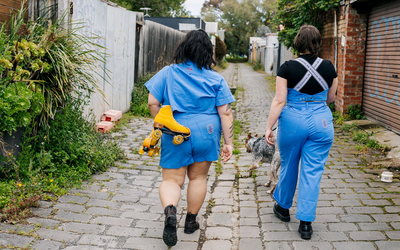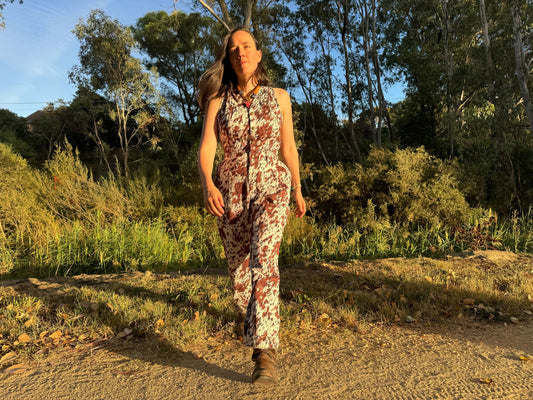What is a Boiler Suit?
By definition, a boiler suit is a loose-fitting garment that covers the whole body, leaving only the hands, feet, neck and head exposed. The suit is cinched at the waist, and opens from fly to collar by zips or snap-fastenings. While the boiler suit has no recorded inventor, fashion historians agree it originated during the Industrial Revolution. Historians theorise it was invented for mechanics on trains and ships who tended to coal-fired boilers. Workers would have to crawl through soot-caked manholes, the cinched one-piece garment stopped soot from dirtying their work clothes, and didn’t snag in confined spaces. By the early 20th century, the boiler suit would gain worldwide popularity. In a fascinating interview given to Myf Warhurst on ABC Radio National, fashion historian Lidia Edwards explains how an Australian WW1 pilot, Sidney Cotton, was partially responsible for this phenomenon. In 1917, Cotton invented a flight suit for aviators known as the ‘Sidcot’ — effectively a boiler suit which protected pilots from freezing temperatures at high altitudes. ‘This very efficient item of protective flying clothing became highly prized by all aircrew issued with them....and was the first item to be 'confiscated' from a British pilot taken prisoner by the Germans.’[1]

A Uniform for World War II
While the Sidcot was becoming world famous, women were signing up en masse during the war effort to labour in munitions factories and ship yards. The boiler suit was a standard garment on factory floors, and was later iconised in Western cultural imagination by the fictional feminist worker, ‘Rosie the Riveter’, who flexes her bicep under a rolled up blue boiler suit.
In the 1920’s and 30’s the boiler suit quickly found favour outside of factories and farmyards, it started to appear on the streets and in artistic and intellectual circles. In sympathy with the workers and proletariat, it was worn by members of the Bauhaus school and was the unofficial uniform of anarchists during the Spanish civil war, amongst others.
Moreover, in the UK during WW2 every woman, man, and child living in a metropolitan British city would have had one. Named ‘siren-suits’, these were designed to be slipped over clothes at short notice once bombing sirens went off. Incredibly, the siren-suit became one of Winston Churchill’s favourite garments. The British PM had several made for himself by the Jerymn Street tailor, Turnbull and Asser, in pinstripe wool and lush velvets. Churchill even wore one on a formal state visit to meet US President Franklin D. Roosevelt in 1941, while Britain and America were making D-Day preparations.


"...the queerest piece of clothing ever invented."
The Femme Revolution: 2021 and Beyond
Fast forward several decades and SÜK has reinevented the boiler suit to honour hard working femmes and tradeswomen. Function, sexuality, fluidity, integrity and fierceness combine to champion feminine expression, rather than attempting to dismiss and disguise under the usual workwear norm. Our boiler suit is the culmination of several prototypes & years of research.
The quality of our boiler is impeccable. Made of a flexible, hard-wearing 310 gsm cotton drill, the SÜK boiler allows the body to perform complicated tasks whilst keeping you protected. Fully enclosed, reinforced seams for maximum strength and comfort. Brass hardware detailing. This garment is made to be lived, worn and worked in.


Gloria (left) wears the Boiler Suit in Green. Riana (right) wears the Boiler Suit in Black.
Join us in the Femme Revolution!
Shop our collection of boiler suits here.
You can read more about Boiler Suits at the links below:




